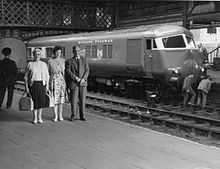Midland Pullman

The Midland Pullman was the name given to a former express passenger train service operating on British Railways' old Midland Main Line between London St Pancras and Manchester Central via Leicester and Millers Dale. The train completed the journey in 3 hours 15 minutes.
Blue Pullman
In July 1960 the Midland Pullman was relaunched as a luxury all-first-class service using two new Blue Pullman six-car diesel-electric units, aimed at covering the high end of the Manchester-London business market while services on the West Coast Main Line were disrupted during electrification. It called only at Cheadle Heath (now closed), and made the journey from London to Manchester in a record 3 hours 15 minutes. The best time between the two cities immediately previously had been 3 hours 50 minutes.[1]
The Midland Pullman ran every weekday, up to London in the morning and down to Manchester in the evening. To fill in between these turns, there was an afternoon return trip from St Pancras to Nottingham [2] described by railway staff as "The most luxurious ECS*[3] in the world." The train had two kitchens, and a full meal service was provided at every seat.[4]

The operation attracted criticism because being a fixed-formation train it required a full spare set, making poor use of expensive assets. Critics also noted that the new service was not best timed for priority business use: initially the up Midland Pullman did not leave Manchester until 0900.[4]
Other commentators, however, praised the speed and smoothness of the journey and the luxury of the trains.[citation needed] Trains were later re-timed to suit business travellers better.
The service was withdrawn in 1966 and replaced by the electric-locomotive-hauled Manchester Pullman running from Manchester Piccadilly to London Euston via the newly-electrified West Coast Main Line, with a much-reduced journey time of 2 hours 30 minutes,[5] marking the end of the Midland line as a significant route for Manchester-London traffic.
An attempt was made to find work for it on the East Coast Main Line but, plagued as it was by rough-riding bogies, it was never run in revenue-earning service.[2]
See also
References
- ↑ The ABC Railway Guide. London: Thomas Skinner. February 1960. p. 243.
- ↑ 2.0 2.1 Bentley, C., (1997) British Railways Operating History: Volume One, The Peak District, Carnarvon: XPress Publishing.
- ↑ Empty coaching stock
- ↑ 4.0 4.1 G. Freeman Allen (December 1959). "Talking of trains: The 'Midland Pullman'". Trains Illustrated (Hampton Court: Ian Allan). p. 574.
- ↑ Passenger Timetable 1 May 1972 to 6 May 1973. London: British Railways, London Midland Region. p. 96.